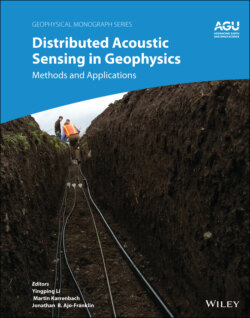Читать книгу Distributed Acoustic Sensing in Geophysics - Группа авторов - Страница 72
4.2. PRINCIPLE
ОглавлениеThe principle of PGC‐DAS system is shown in Figure 4.1. A coherent input light pulse passes through a circulator into the sensing optical fiber. RB light enters into an unbalanced MI with FRMs at the ends. There is a phase modulator on one arm of MI and an optical delay LMI on the other arm. RB signal mixes with itself and is detected by one photoelectric detector (PD).
Intensity distribution of RB light is a type of Fourier transform of random permittivity fluctuations (Bao et al., 2016). Assume that the sensing fiber is composed of successive slices with a length of ΔL. Each slice contains M scattering centers, and polarization states between each scattering center are consistent. The interference field of backscattered light at distance Lm = mΔL can be expressed by (Park et al., 1998):
(4.1)
where E0 is electric field intensity of the incident light; Pm is polarization‐dependent coefficient ranging from 0 to 1; α is optical power attenuation coefficient; rk and φk are scattering coefficient and phase of the kth scattering center, respectively; ai and φi are reflectivity and phase of scattering unit, respectively; and β is propagation constant.
Figure 4.1 Principle of PGC‐DAS system with an unbalanced MI.
Then, scattering light enters into MI, and RB1 and RB2 separated by LMI interference due to the same optical path. The interference electrical field E(t) is written as:
(4.2)
With simplified coefficients A and B, the interference intensity is given by:
(4.3)
For PGC demodulation algorithm, a sinusoidal signal with a modulation frequency of ωc is loaded on one arm of MI. Therefore, an additional phase modulation C ⋅ cos (ωct) is introduced in Equation 4.3 with C = mΔLMI, where m is the modulation index and ΔLMI is the maximum length difference variation. Hence, the total phase of the interference light is:
(4.4)
And the interference intensity is rewritten as:
(4.5)
After being multiplied separately with fundamental and second harmonic carriers cos(ωct) andcos(2ωct), and later with low‐pass filtering, the in‐phase and quadrature components II(t) and IQ(t) are represented as (Dandridge et al., 1982):
(4.6)
where J1(C) and J2(C) are the first‐order and the second‐order Bessel function, respectively, of the first kind. When C is equal to 2.63, it satisfies J1(C) = J2(C). Thus, the phase φ(t) is calculated by:
(4.7)
